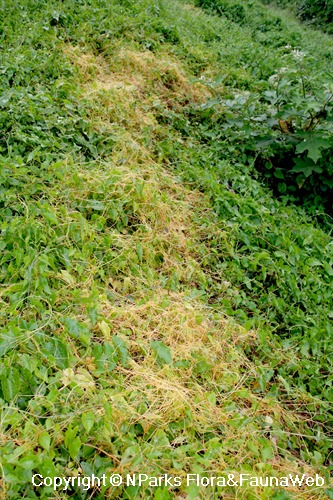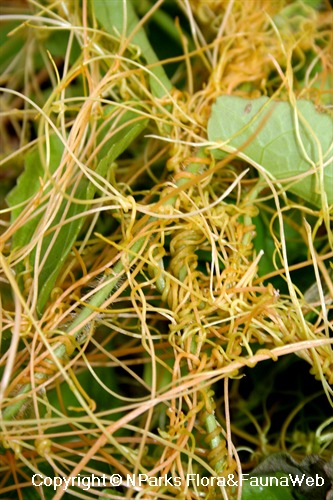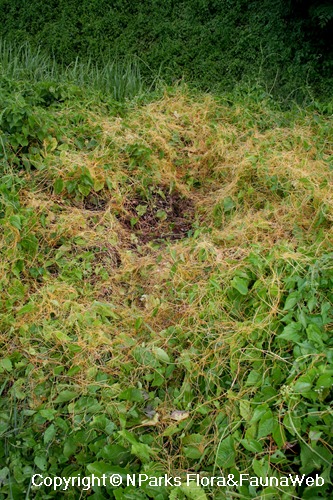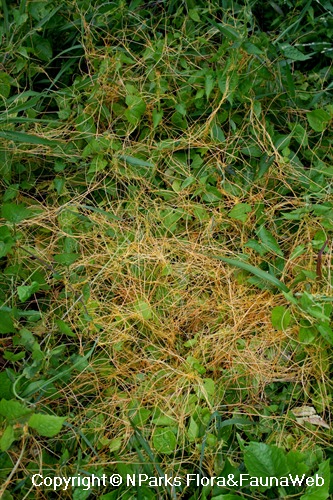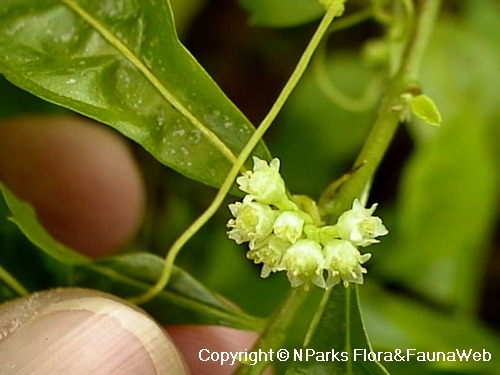
Back
Cuscuta australis R. Br.
| Family Name: | Convolvulaceae |
| Synonyms: | Cuscuta obtusiflora var. cordofana, Cuscuta hygrophilae, Cuscuta kawakamii, Cuscuta obtusiflora var. australis, Cuscuta obtusiflora, Cuscuta cordofana, Cuscuta millettii, Cuscuta tasmanica |
| Common Name: | Southern Dodder, 南方菟丝子, 无根草, 豆虎, 菟丝, 金丝草, 吐血丝, 天碧草 |
Name
Classifications and Characteristics
| Plant Division | Angiosperms (Flowering Seed Plants) (Dicotyledon) |
|---|---|
| Plant Growth Form | Climber, Herbaceous Plant |
| Lifespan (in Singapore) | Perennial |
| Mode of Nutrition | Heterotrophic (Symbiotic - Parasite of) |
Biogeography
| Native Distribution | Africa, Europe, Asia, Australia, Paleotropics |
|---|---|
| Native Habitat | Terrestrial (Secondary Rainforest, Monsoon Forest, Temperate Forest, Grassland / Savannah/ Scrubland, Disturbed Area / Open Ground) |
| Preferred Climate Zone | Tropical, Sub-Tropical / Monsoonal, Temperate, Mediterranean |
Description and Ethnobotany
| Ethnobotanical Uses | Food (Herb or Spice) Others: Whole plant and seeds have a number of medicinal uses. |
|---|
Landscaping Features
| Desirable Plant Features | Ornamental Stems |
|---|
Fauna, Pollination and Dispersal
| Seed or Spore Dispersal | Abiotic (Explosive Dehiscence) |
|---|
Plant Care and Propagation
| Light Preference | Full Sun |
|---|---|
| Water Preference | Little Water |
| Plant Growth Rate | Fast |
| Rootzone Tolerance | Drought Tolerant |
| Propagation Method | Seed |
Foliar
| Mature Foliage Colour(s) | Green |
|---|---|
| Foliar Modification | Reduced / Needle-like |
Non - Foliar and Storage
| Stem Type & Modification | Herbaceous, Runner / Stolon |
|---|---|
| Root Type | Underground (Fibrous Root) |
Floral (Angiosperm)
| Flower & Plant Sexuality | Bisexual Flowers |
| Flower Colour(s) | White |
|---|
Fruit, Seed and Spore
| Mature Fruit Colour(s) | Brown, Red |
|---|---|
| Fruit Classification | Simple Fruit |
| Fruit Type | Dehiscent Dry Fruit , Capsule |
Image Repository
Others
| Master ID | 86 |
|---|---|
| Species ID | 1382 |
| Flora Disclaimer | The information in this website has been compiled from reliable sources, such as reference works on medicinal plants. It is not a substitute for medical advice or treatment and NParks does not purport to provide any medical advice. Readers should always consult his/her physician before using or consuming a plant for medicinal purposes. |

